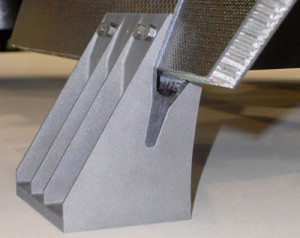 The newest satellites manufactured by Airbus Defence and Space (ADS) feature special clamps that connect the body of a satellite to the feed and sub-reflector assembly at the top end. Clamps manufactured by conventional production methods did not meet the expectations of ADS’s Spanish corporate division. The engineers thus chose the additive-metal-manufacturing technique from EOS for production. This process, where metal powder coats are fused by laser, also allows for easy adaptation of the component’s design. The components can now cope with the required operating temperature range of 330°C and at force effects of 20 kN permanently without showing structural or performance problems. The Spanish aerospace experts were also able to reduce production time for the clamps by five days. Consequently, less than one month is now needed to assemble the three holding devices needed for each satellite. EOS says the costs savings during the new production process are more than 20 %. Moreover, the engineers have reduced the weight of the component.
The newest satellites manufactured by Airbus Defence and Space (ADS) feature special clamps that connect the body of a satellite to the feed and sub-reflector assembly at the top end. Clamps manufactured by conventional production methods did not meet the expectations of ADS’s Spanish corporate division. The engineers thus chose the additive-metal-manufacturing technique from EOS for production. This process, where metal powder coats are fused by laser, also allows for easy adaptation of the component’s design. The components can now cope with the required operating temperature range of 330°C and at force effects of 20 kN permanently without showing structural or performance problems. The Spanish aerospace experts were also able to reduce production time for the clamps by five days. Consequently, less than one month is now needed to assemble the three holding devices needed for each satellite. EOS says the costs savings during the new production process are more than 20 %. Moreover, the engineers have reduced the weight of the component.
With the new manufacturing process, titanium can still be used as the material of construction – as it is so often required in the aerospace industry. Apart from its advantages in terms of absolute weight and thermal diffusivity, titanium also offers acceptable specific weight properties. The new fixtures can support the components to be mounted safely on the body, while attenuating the significant variations in temperature experienced in space, which can range from -180 to 150°C, causing great strain on the materials of construction. Otilia Castro Matías from Airbus Defence and Space explained, “The EOS additive manufacturing solution has two advantages: firstly, we can optimize the production ourselves. In addition, we can improve our designs so that the complete work piece can now be manufactured in one operation.”



